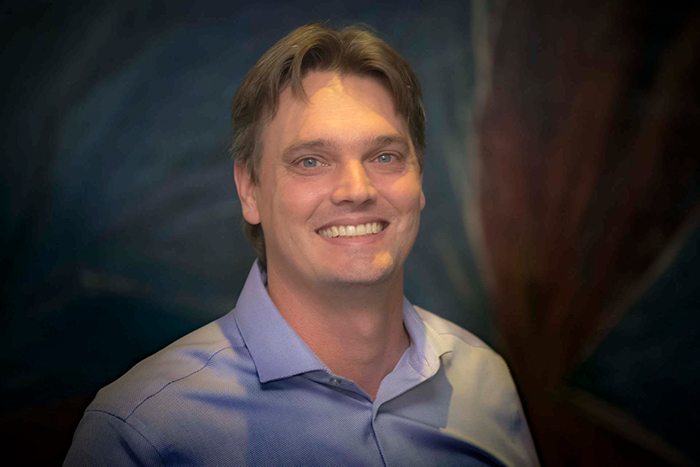Former LLNL Scientist Wins E.O. Lawrence Award
February 25, 2021
 Lawrence Award winner Dustin Froula, professor of physics and a distinguished scientist at the University of Rochester’s Laboratory for Laser Energetics, began his career at Lawrence Livermore National Laboratory. Credit: Eugene Kowaluk/University of Rochester Laboratory for Laser Energetics
Lawrence Award winner Dustin Froula, professor of physics and a distinguished scientist at the University of Rochester’s Laboratory for Laser Energetics, began his career at Lawrence Livermore National Laboratory. Credit: Eugene Kowaluk/University of Rochester Laboratory for Laser Energetics Former LLNL scientist Dustin Froula, who helped develop what has become a transformational diagnostic at NIF, was recently honored with the Ernest Orlando Lawrence Award for his groundbreaking research on inertial confinement fusion and plasma sciences.
Froula, a professor of physics and a distinguished scientist at the University of Rochester’s Laboratory for Laser Energetics (LLE), received the award from the U.S. Department of Energy (DOE) for his “seminal and creative contributions in fundamental laser-matter interaction physics, and laser-driven plasma accelerators that have significantly advanced the Department of Energy’s mission.”
Froula is one of eight scientists at national research laboratories who were recognized this year with the award named for LLNL co-founder Ernest O. Lawrence.
The award recognizes mid-career U.S. scientists and engineers for exceptional scientific, technical, and engineering achievements related to the broad missions of the DOE and its programs to further science, energy, and national security.
“The Lawrence Award is one of the most prestigious awards given by the DOE,” said LLE Director Michael Campbell. “The award recognizes Dustin’s outstanding career and impact in plasma physics. It also gives evidence of the quality and dedication of scientists, engineers, and support staff at the university and LLE. Dustin’s research has been funded by both the DOE’s National Nuclear Security Administration (NNSA) and the Office of Fusion Energy Sciences. The outstanding program managers in these offices have enabled the research that has led to this award.”
In his acceptance speech, Froula described it as “an incredible honor to be recognized with the Lawrence Award for the work that we have done with the Department of Energy. The accomplishments that have led to this award would never have happened without the numerous people in my life who have supported, educated, and mentored me.”
In particular, Froula thanked his wife and three children, as well as his father, a second-generation physicist, and his mother for setting “my foundation for success and my drive to continue to ask the question of ‘how it works.’ ”
Froula’s scientific career with the DOE began with an undergraduate research internship at LLNL, where he studied fusion through sonoluminescence, the optical emission from an acoustically driven imploding bubble.
Froula described LLNL as a “scientist’s ‘candy store’—an institution where access to instruments allowed its scientists, including students, to follow their unbounded ideas while providing unfettered access to experts on nearly every subject.”
Froula first implemented and developed the optical Thomson scattering technique on LLE’s OMEGA Laser Facility as a graduate student working in the NIF & Photon Science Directorate. The technique has now grown into a routine diagnostic used in nearly one-third of OMEGA experiments. It was one of the diagnostics used in the research of cosmic magnetic fields.
The prolific use of optical Thomson scattering helped it become a transformational diagnostic for NIF. It is currently being used at NIF to study plasma conditions in a variety of experiments, including those measuring conditions in hohlraum laser entrance holes.
Froula’s research addresses long-standing questions in plasma physics, including building a better understanding of how laser beams propagate through and interact with plasmas during laser-based experiments.
He also opened a new field of optics based on the concept of “flying focus,” a technique that enables researchers to better control the intensity of lasers over long distances. The technique has the potential to help researchers design the next generation of high-power, laser-driven particle accelerators, and light sources with novel wavelengths for studying complex materials and molecules.
Froula earned his Ph.D. at the University of California, Davis, in 2002 and went on to LLNL before arriving at Rochester in 2010. He has published more than 200 peer-reviewed papers and is a fellow of the American Physical Society (APS). In 2019, he was awarded the APS’s John Dawson Award for excellence in plasma physics research.
Froula is one of three LLE scientists who have received the Lawrence Award: Campbell received the award in 1994 and Ricardo Betti, LLE’s chief scientist and professor of mechanical engineering, received the award in 2011.
—Lindsey Valich, University of Rochester, and Jon Kawamoto
Follow us on Twitter: @lasers_llnl



